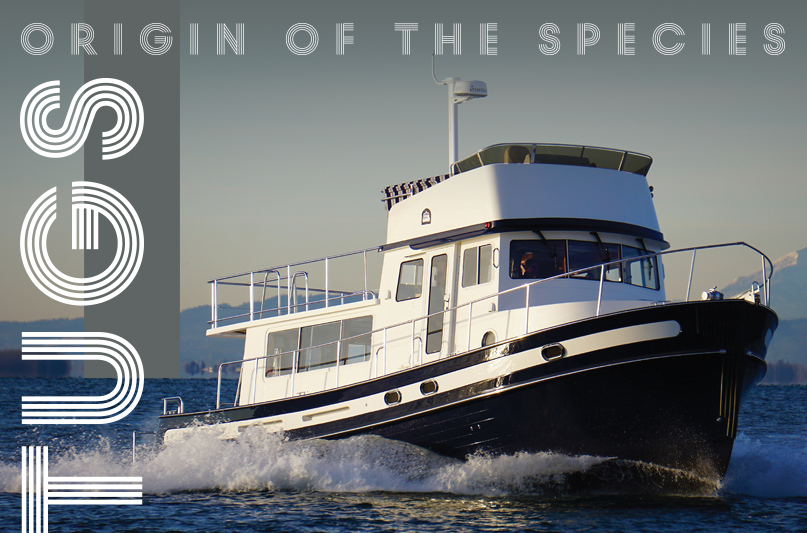
 It is a summer morning and we are slowly motoring north past Elliott Bay. Other than the ferries nimbly coming and going from downtown Seattle, there seems to be no one else on the water. Then, quietly and quickly, a massive commercial tug appears in our wake, its yellow and blue color scheme unmistakable, even in the poor visibility of the morning. We sip our coffee and watch, transfixed by the grace of this massive ship that is slowly overtaking us. Soon she is off our stern and then makes a turn to starboard, headed for the Ballard Locks and eventually her home on the Lake Washington Ship Canal.
It is a summer morning and we are slowly motoring north past Elliott Bay. Other than the ferries nimbly coming and going from downtown Seattle, there seems to be no one else on the water. Then, quietly and quickly, a massive commercial tug appears in our wake, its yellow and blue color scheme unmistakable, even in the poor visibility of the morning. We sip our coffee and watch, transfixed by the grace of this massive ship that is slowly overtaking us. Soon she is off our stern and then makes a turn to starboard, headed for the Ballard Locks and eventually her home on the Lake Washington Ship Canal.
Working tugs are so common near the ports of Puget Sound that they are part of the tableau. An amateur painter would be just as likely to produce a watercolor with a tugboat in the foreground as a ferry. Tugs seem to belong here. The rugged landscape and harsh industrial facades of our port cities provide the perfect backdrop for the graceful workboats. Freighters always seem outsized and out of place as they come and go through the shipping lanes. Ferries loudly announce their presence as they disembark. Tugs go largely unnoticed. They simply blend in. They are natives in our waters.
This likely explains the popularity of modern recreational tugs, many of which are built in the Pacific Northwest. Not tug boats at all, the class of slow cruisers called tugs are nonetheless a nod to the history and culture of the Salish Sea.
=Tug boats have been working the waters of Puget Sound since 1836, when the SS Beaver became the first steamship in the Northwest. The Beaver plied the waters from the Columbia River to Alaska. Used mostly in support of the fur trade, the Beaver was also called into duty towing becalmed sailing vessels in and out of ports and over the Columbia River bar. The Beaver went aground near Vancouver under the command of a drunk crew in 1888. Her remains, including one of her paddle wheels, can be seen today at the Vancouver Maritime Museum in British Columbia.
The same forces that require the use of working tugs today are what pressed them into service in the 1890s. In the years of overlap between sail and steam, motorized vessels were a premium. Sailing ships remained the only true option for crossing oceans but were hobbled in the shifting winds and strong currents of the Puget Sound. Ships loaded with cargo would be intercepted at the mouth of the Straits of Juan de Fuca and towed into Port Townsend, Seattle, and Tacoma.
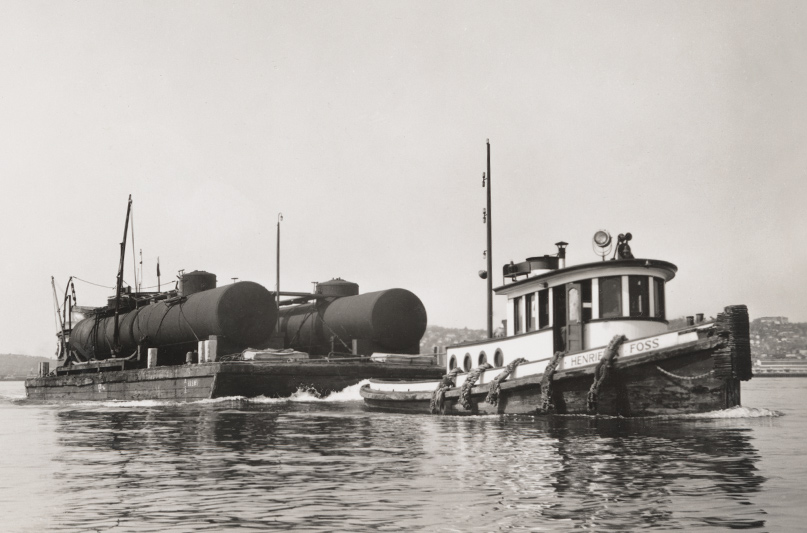
Lumber towns like Port Gamble, Utsalady, Seabeck, and Port Ludlow had steamships stationed at their docks to tow log rafts from the wooded hillsides to the mills, where the resulting lumber would then be loaded onto sailing vessels destined for San Francisco and other far away cities.
As commerce in the Pacific Northwest rapidly expanded, so did the need for a fleet of tugboats. Moving goods by water was (and largely still is) the preferred method, since railroads and roads were incomplete and interrupted by the geography of Puget Sound. Delivering supplies north during the Gold Rush and shipping products back to the cities of Seattle and Vancouver required steam-powered vessels to ply the Inside Passage, a safe but frustratingly fickle path.
The Second World War harkened a construction boom still unmatched in American history. The industrial output in support of the America war effort included huge fleets of tug boats used to position ships, deliver materials to shipyards like the one in Bremerton, and move ammunition from base to base. After the war, many of the over 800 tugs built by the U.S. Navy made their way into private service.
Today, modern diesel-powered tugboats perform similar duty as their predecessors. Container ships enter the Puget Sound under their own power but are intercepted and towed into port by two or more tugs. Log rafts and barges loaded with everything from sawdust to construction equipment quietly make their way up and down the Inside Passage. Ferries that have suffered mechanical failure are pulled home for repair.
Most modern tugs are built on the same concept: deep draft, full displacement steel hulls topped with low-slung decks and stout cabins. Massive propellers are fitted for torque and low-end power, not speed. Larger tugs are fitted with twin screws and a variety of thrusters. Crew accommodations are typically workman-like and the wheelhouses are all business.
Many tugs you see on the water are purposely built for specific duty. Smaller, more nimble vessels are used around ports to push or pull barges or other vessels. Larger, more powerful ships are tasked with pulling loaded barges and specialty cargo.
Being on the deck of a working tug gives you an immediate taste of the heavy-duty work they perform. Fittings are massive and unapologetically industrial. These are no-nonsense ships meant to do real work, and do it often.
No one was better positioned to take advantage of the first “tug boom” than Thea Foss. As the story goes, Foss, an immigrant from Norway, was at home on the Tacoma waterfront in 1889 while her carpenter husband was off building a home in the woods. A frustrated fisherman, fed up with his own failure, sold his rowboat to Foss for five dollars, a large but manageable sum for Foss. Soon after, she paints the boat bright white with green trim and resells it for fifteen dollars. She repeats this several times, and by the time her husband emerges from his carpentry job some time later with $32 in his pocket, Thea has put away over $41 from buying, selling, and renting rowboats to fishermen.
This was enough to convince Andrew Foss to quit building houses and sheds and focus on building boats, and from that beginning we get the origins of the Foss Maritime, the source of the ubiquitous green and white hulled ships that work the waters around Seattle and Tacoma every day.
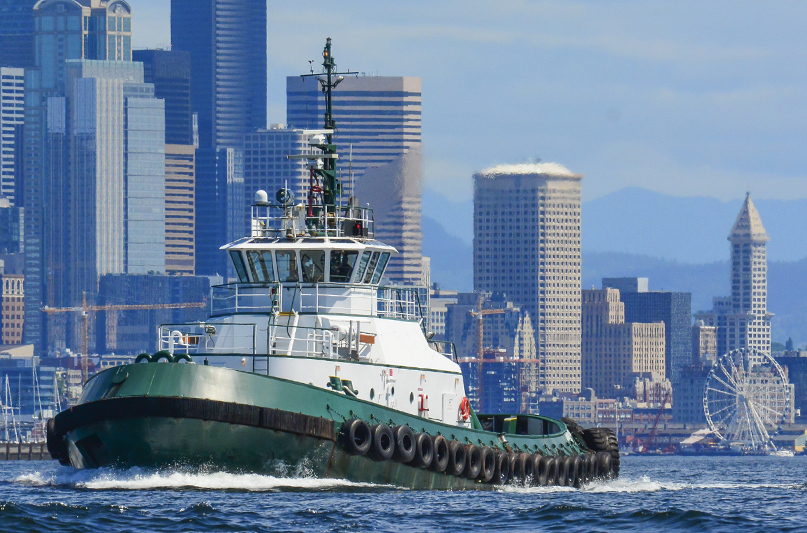
Andrew and Thea Foss built and rented or sold over 200 boats to local fishermen and workers who used them to row to their jobs at local sawmills. They acquired their first steam vessel when it went aground at the head of Commencement Bay and they salvaged the stranded vessel. The equipment was used to outfit a new hull built by Andrew. They sold this boat and bought yet another, and the company began to flourish and expand. Among Andrew Foss’s most prescient design ideas was a short, heavy tug designed to move log rafts.
Today, Foss Maritime is based in Seattle and employs thousands of men and women around the world. Their fleet of over 200 vessels work the waters of the Puget Sound and the world. Their vessels still have the trademark white-on-green paint jobs started by Thea Foss in 1889.
Just as recognizable on the waters of the Puget Sound are the blue and yellow ships of the Western Towboat Company. Established in Ballard in 1948, Western Towboat started with one boat—the Tobey. The Tobey worked the waters of the Seattle waterfront for years, with Bob Shrewsbury Sr. running the entire operation on handshake deals and word of mouth promotion.
Today, family-owned and operated Western Towboat has 22 vessels working up and down the West Coast. Their ships are designed and built in their own yard in Seattle, where they fabricate and design much of their own equipment. The operation is impressive, and the years of experience in building their own vessels has led to efficiencies and procedures that keep Western’s boats constantly working. For example, most of their larger boats have removable stacks, which allows the yard to have access to the engines without cutting the deck. According to Bob Shrewsbury Jr., one of the family owners, they can refit an engine in 30 hours at their dock in Ballard and be back on the water.
Western’s tugs pull barges of containers and railcars from Seattle to Southeast Alaska on what seems like an impossible schedule, leaving port in Seattle every Wednesday and Friday with up to ten stops in Alaska before returning. The 15- to 20-day round trip ends with a few days off at home for the captain and crew before setting out again. This explains the care that is taken in the design and maintenance of the boats’ interiors.
The cabins and engine rooms of Western’s vessels would make any yacht owner envious. While their vessels are obviously working ships, specifically built for the jobs they need to do, they are also designed and maintained to assure the comfort and happiness of the captain and crew. As I walk through the cabin of the Artic Titan, a 120’ ship built in 2012, I marvel at the accommodations and wish my own boat was as well put together.
“This is their home,” Bob says, as we tour the Arctic Titan. “It’s in their interest to take good care of it.”
Much in the way high-level yacht racing innovations trickle down into recreational sailing, modern tug design is informing design and technologies in cruising yachts. The competitive world of the shipping industry necessitates a constant rethinking of the tug’s hull design, propulsion, and crew accommodations.
Western Towboat’s design and construction process emphasizes long-term reliability and maintenance, as well as state of the art propulsion and electronics.
As we walk the yard, Bob tells me about his first trip to Alaska at age seven on a boat called the Sally S, which Western Towboat purchased in 1951. Today the Sally S still sails the waters of Puget Sound, lovingly converted into a pleasure yacht by the current owners.
It did not take long for working tugs to be pressed into recreational service. As tug companies upgraded to newer technologies and sold older, out-of-date vessels, private owners began converting them into cruising yachts and liveaboards. The appeal is obvious. The rugged, seaworthy tug hulls were roomy and stout. Their proven pedigree in Northwest waters assured they could take anything thrown their way.
Many overly ambitious buyers quickly realized that the cost of refitting a working tug to be a comfortable cruising platform was immense, but those with resources and foresight created wonderful yachts from the bones of working boats.

A shining example of a conversion from workboat to pleasure craft is the classic Canadian tug Swell. She was launched in 1912 as a coal-powered steam vessel. In the 1950s she was converted to a diesel power plant. She began her gradual march toward becoming a pleasure craft in 1972. She was used as a yacht for seven years before being put back into service as a tug until 2004. This alone speaks to the quality of the design and construction of tugs, even one as old as the Swell. Today, after a complete $3.5 million refit she serves as a charter vessel for Maple Leaf Adventures in British Columbia.
While cruising the Puget Sound, you are bound to see old tugs from the early 1900s still serving as pleasure boats, but the wood hulled boats are becoming more and more rare as the cost of maintaining them increases.
While early conversions were obviously workboats repurposed as cruising vessels, the recreational boats we refer to now as tugs are not tugs at all. While the cabin and topsides resemble the shape and aesthetic of workboats, most cruising “tugs” are semi-displacement hulls with fuel efficiency and comfort in mind. The most industrial pursuit for many of these vessels is recreational salmon fishing and crabbing.
Still, the stout profiles, plumb bows, and low-slung aft decks of modern cruising tugs are right at home on the waters in the Northwest. They are heavily built to withstand the rigors of an Inside Passage voyage while still being efficient and elegant. You aren’t going anywhere fast in a cruising tug, but you are getting there safely and without burning your cruising budget on fuel.
There have been several recreational tug manufacturers over the years, and a few Northwest companies stand out as notable examples.
The oil crisis of the 1970s led designers Jerry Husted and Lynn Senour to envision a cruising yacht that was fuel efficient and comfortable. The key to this, of course, was a slower boat powered by an efficient engine. That idea that flew in the face of the contemporary notion of bigger and faster, but the designers were confident that yacht buyers in the Pacific Northwest would be drawn to the workman-like design of a tug. Men, they reasoned, would find the tug design strong and rugged. Women would find it cute. The boat would look good going slow and be efficient.
The answer to the design puzzle was a semi-displacement hull that was stable and efficient through the water. Without the need to push a heavy boat onto a plane, the engines could be undersized by contemporary standards, and the boat would sip fuel as it pushed its way through the water.
The crossover from workboat to pleasure craft wasn’t quite complete, however. When the Nordic Tug 26 was introduced at the 1980 Seattle International Boat show, one was sold every three hours.
Most were sold to cruisers, but a fair number were bought by companies and put into service as work boats. Their seaworthy and efficient design led some buyers to treat them like pickup trucks: transporting crew, towing other craft around ports, and hauling equipment.
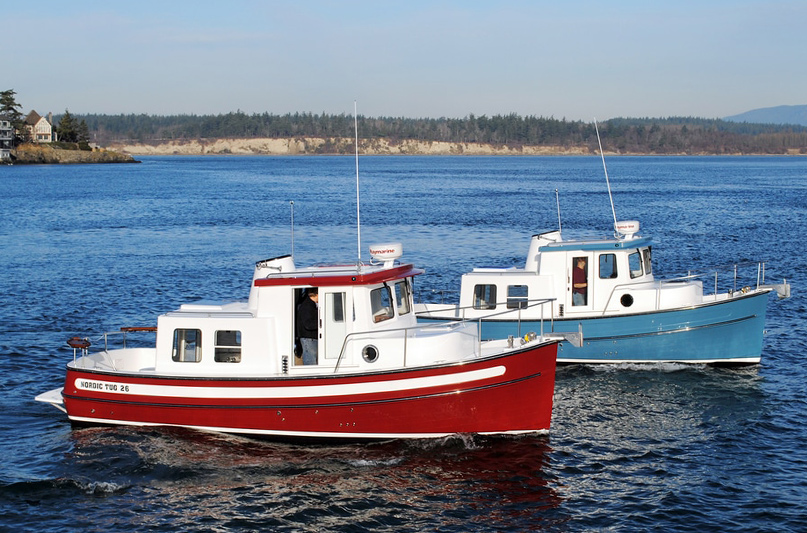
The original 26’ design was incredibly efficient, burning half a gallon of diesel an hour. Though they halted production of the smallest model in 1997, you will still see lovingly cared for Nordic Tug 26s at every marina in the Northwest.
Nordic Tugs today are unmistakably pleasure craft. Roomy aft decks, swim steps, ample cabins and salons that would be comfortable on dry land make them a fan favorite at boat shows and on the docks. I can never resist an invitation aboard someone’s Nordic Tug. Any boater who appreciates attention to craftsmanship and detail will be taken by these boats, and with good reason.
Tom Nelson, Mike Schoppert, and Kurt Dilworth formed Tomco Marine Group with the mission to create seaworthy and appealing pleasure boats. Lynn Senour was an early contributor to the design, and Tom is the former president of Nordic Tugs. The crossover and Northwest pedigree is obvious. Senour designed both the original hull used on the American Tug 34, launched in 2000, and the first Nordic Tugs.
While the name of the boats and the look above the waterline suggest a tugboat heritage, the American Tugs are actually born from the fishing industry. According to Dilworth, “The hull of the American Tug 34 was originally used as a Bristol Bay fishing boat that was produced in the late 70s and early 80s.”
No yacht on the water screams of seaworthiness more than American Tugs. Their signature high freeboard, stout gunwales, and forward sweeping wheelhouse look at home pounding through the waves. They are imposing boats, which makes their cruising interiors seem almost incongruous. But these are pleasure craft, not workboats. Built on a solid fiberglass hull and very well-equipped, American Tugs are definitely close siblings to the workboats that inspired their design. American Tug owners are year-round cruisers, working their way up and down the Inside Passage and down the coast, and the boats are built with this in mind.
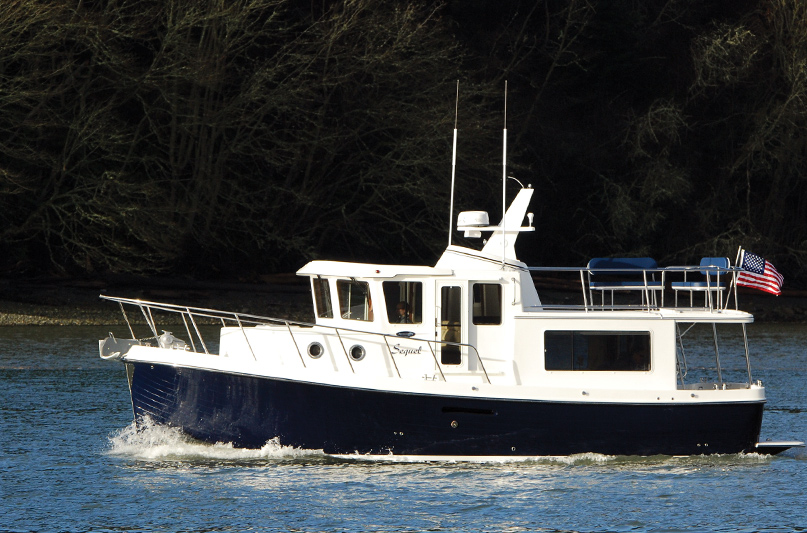
The Salish Sea seems to be meant for slow cruisers. On waters where the journey is indeed the destination, cruising at low speeds through channels and passes just feels right. Recreational tug and trawler owners see more and are simply more attuned to the waters around them than those who race from port to port.
Modern cruising tugs share an aesthetic commonality with the working boats of the Northwest coast, but in everything but appearance, they are cruisers. The rugged features of our coastlines and industrial cities provide a fitting backdrop for modern cruising tugs. Just as working tugs seem as much a part of the landscape as ferries and orca whales, recreational tugs are at home here. Their Northwest pedigree is obvious and stark. Seeing a tug out of context on the east coast or in the Caribbean makes one a little uneasy.
Read the full story on Issuu
Special thanks to Wilde Yachts / Nordic Tugs for photographic assistance.



2 comments
Are you familiar with the Pilgrim 40’s that were built in Canada in the 1980’s! We had one, and lived aboard it for seven years at Silver Gate Yacht Club in San Diego, CA. It was a fun boat, and a delightful livaboard home.
The story has it correct. The pleasure crafts called “tugs” have absolutely nothing in common with a tug. Harbour tugs or “push boats” . I’ve never seen a true work boat tug made of fiberglass.
Such a slap in the face for true workhorses.